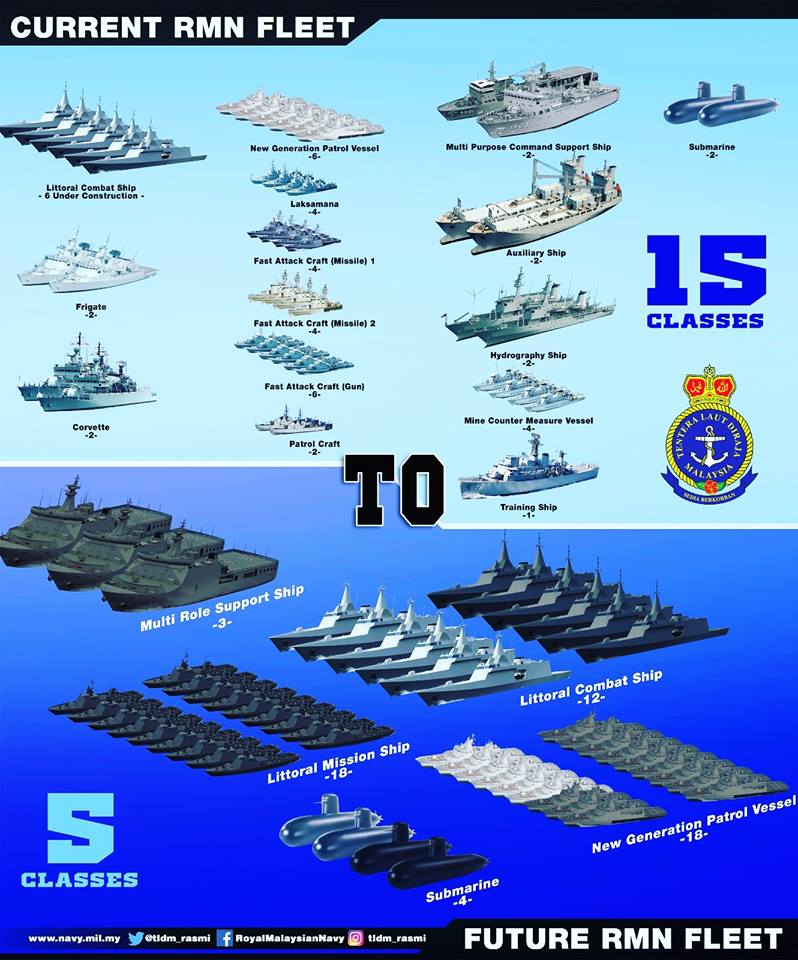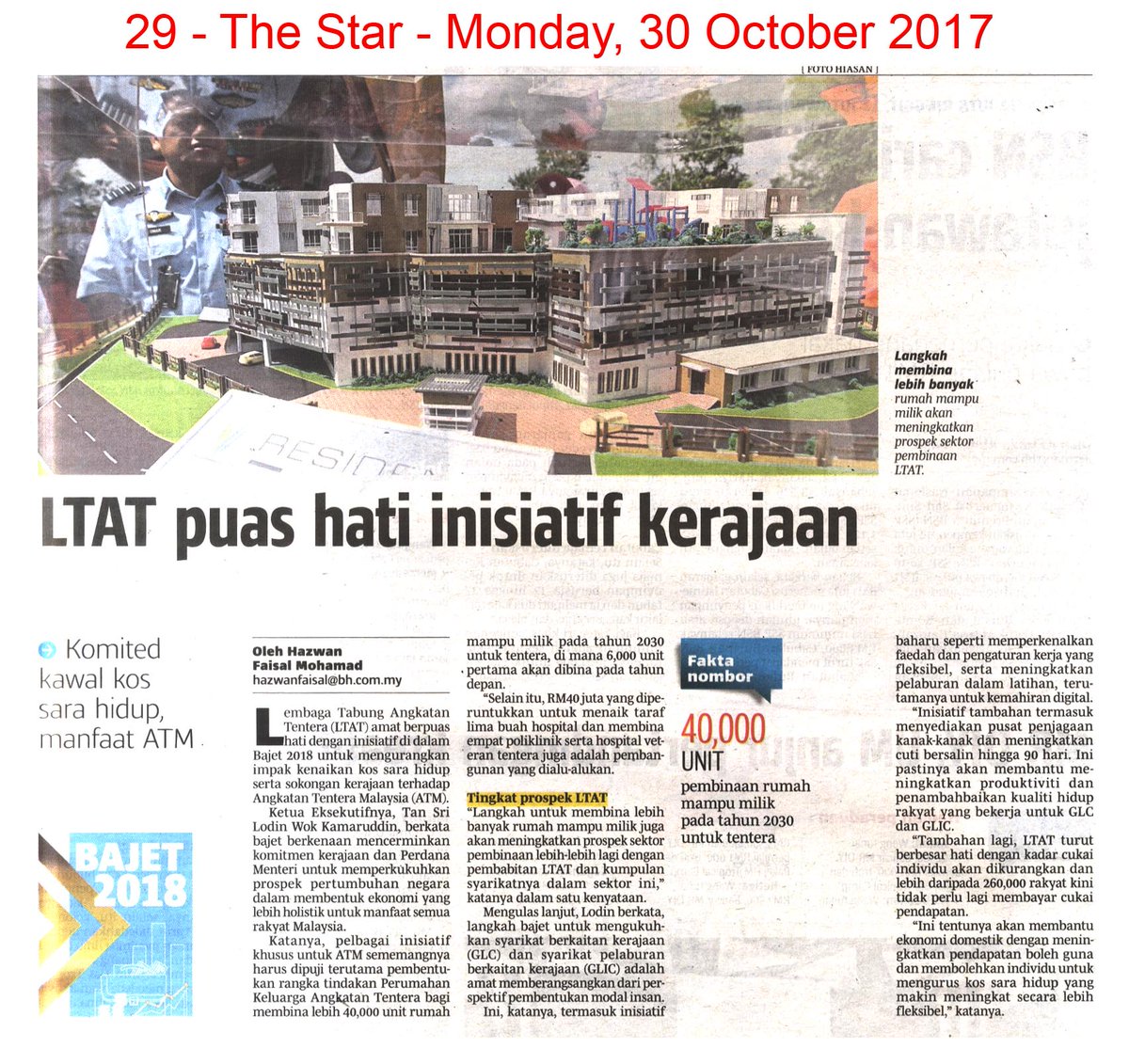Malaysia Announces 5.3% Defence Budget Increase

The Malaysian government has announced that defence spending will increase by 5.3% under the 2018 budget. Total spending on the Ministry of Defence (MoD) will rise from MYR15.1 billion (USD3.6 billion) to MYR15.9 billion.
Spending will decline marginally against GDP, remaining at a level of around 1.1, and as a share of overall government spending from 5.8% to 5.6%. Despite that, the MoD’s budget allocation is still around 7% lower than in 2015 following a large cut to military spending in 2016.
The additional funding will be allocated within the recurrent budget which incorporates the operating costs of the MoD and the armed forces, with related spending rising by 7.6% from MYR11.7 billion to MYR12.6 billion. (Jane's)
Budget 2018 Allocations Enhances MAF's Capabilities - Armed Forces Chief
The RM14-billion allocation to the Malaysian Armed Forces (MAF) in Budget 2018 will enhance the capabilities of the MAF in guarding the sovereignty and security of the country including at the border areas and national waters.
MAF Chief General Tan Sri Raja Mohamed Affandi Raja Mohamed Noor said the allocation would reflect the duties borne by the MAF in preserving the sovereignty of the country.
He was commenting on the allocation announced by Prime Minister Datuk Seri Najib Tun Razak when tabling Budget 2018 in the Dewan Rakyat today.
Meanwhile, Army Chief General Tan Sri Zulkiple Kassim said a part of the allocation would be used to upgrade and equip the assets of the Gerak Khas Group commando team and to install more guard posts along the Sabah and Sarawak borders.
Spending will decline marginally against GDP, remaining at a level of around 1.1, and as a share of overall government spending from 5.8% to 5.6%. Despite that, the MoD’s budget allocation is still around 7% lower than in 2015 following a large cut to military spending in 2016.
The additional funding will be allocated within the recurrent budget which incorporates the operating costs of the MoD and the armed forces, with related spending rising by 7.6% from MYR11.7 billion to MYR12.6 billion. (Jane's)
Budget 2018 Allocations Enhances MAF's Capabilities - Armed Forces Chief
The RM14-billion allocation to the Malaysian Armed Forces (MAF) in Budget 2018 will enhance the capabilities of the MAF in guarding the sovereignty and security of the country including at the border areas and national waters.
MAF Chief General Tan Sri Raja Mohamed Affandi Raja Mohamed Noor said the allocation would reflect the duties borne by the MAF in preserving the sovereignty of the country.
He was commenting on the allocation announced by Prime Minister Datuk Seri Najib Tun Razak when tabling Budget 2018 in the Dewan Rakyat today.

Navy Chief Admiral Tan Sri Ahmad Kamarulzaman Ahmad Badaruddin said the allocation would allow the navy to improve the capability of its littoral combat ships with sophisticated weapons.
"This will enhance maritime safety especially in the Strait of Melaka, the South China Sea and the Sulu Sea," he said.
"This will enhance maritime safety especially in the Strait of Melaka, the South China Sea and the Sulu Sea," he said.
(Bernama)
ESSCom Allocation Shows Goverment's Concern For Sabah Security
The RM250 million allocation given to the Eastern Sabah Security Command (ESSCom) in the 2018 Budget shows the federal government's emphasis on Sabah's security, especially those in the Eastern Sabah Security Zone (ESSZone).
The allocation can strengthen the role of ESSCom in monitoring the ESSZone waters, thus curbing cross-border crimes, including smuggling.
The 2018 Budget tabled by Prime Minister Datuk Seri Najib Tun Razak today, allocated RM250 million to ESSCom to enhance security controls at Sabah and Sarawak borders, including RM50 million for coastal surveillance radar.
ESSCom Allocation Shows Goverment's Concern For Sabah Security
The RM250 million allocation given to the Eastern Sabah Security Command (ESSCom) in the 2018 Budget shows the federal government's emphasis on Sabah's security, especially those in the Eastern Sabah Security Zone (ESSZone).
The allocation can strengthen the role of ESSCom in monitoring the ESSZone waters, thus curbing cross-border crimes, including smuggling.
The 2018 Budget tabled by Prime Minister Datuk Seri Najib Tun Razak today, allocated RM250 million to ESSCom to enhance security controls at Sabah and Sarawak borders, including RM50 million for coastal surveillance radar.
After the budget was released, RMAF official Twitter account announced that the 2018 Budget included funding for four MPA.
MMEA appreciative of RM900 million allocation
Director-general of the Malaysian Maritime Enforcement Agency (MMEA) Admiral Datuk Zulkifili Abu Bakar has thanked the government for the RM900 million allocation to the agency, as announced in the 2018 Budget today.
Zulkifli said the allocation will be used for the agency’s development and management expenditure for next year.
“I am grateful to the government for this allocation. (Of the) total, RM490 million will be used to fund boat and ship maintenance, (and for) patrol ships currently being constructed.
“In this budget, the MMEA, as one of the security forces together with the armed forces and police, has greater and important responsibilities in safeguarding the security, sovereignty and well-being of the people and the country.
“As the national maritime enforcement agency, the MMEA is always committed and responsible in ensuring that the country’s waters are safe and under control,” Zulkifli said in a statement.
Prime Minister Datuk Seri Najib Razak today announced that the government has allocated RM14 billion for the armed forces – including almost RM9 billion to the police and RM900 million to the MMEA – in its 2018 Budget
Director-general of the Malaysian Maritime Enforcement Agency (MMEA) Admiral Datuk Zulkifili Abu Bakar has thanked the government for the RM900 million allocation to the agency, as announced in the 2018 Budget today.
Zulkifli said the allocation will be used for the agency’s development and management expenditure for next year.
“I am grateful to the government for this allocation. (Of the) total, RM490 million will be used to fund boat and ship maintenance, (and for) patrol ships currently being constructed.
“In this budget, the MMEA, as one of the security forces together with the armed forces and police, has greater and important responsibilities in safeguarding the security, sovereignty and well-being of the people and the country.
“As the national maritime enforcement agency, the MMEA is always committed and responsible in ensuring that the country’s waters are safe and under control,” Zulkifli said in a statement.
Prime Minister Datuk Seri Najib Razak today announced that the government has allocated RM14 billion for the armed forces – including almost RM9 billion to the police and RM900 million to the MMEA – in its 2018 Budget
Malaysia allocates MYR50 million towards acquisition of coastal radars in 2018 budget
29 October 2017
The Malaysian government will set aside MYR250 million (USD59 million) from its 2018 national budget to enhance security within the Eastern Sabah Security Zone (ESSZONE), the country’s Prime Minister Najib Razak announced via a parliamentary speech on 27 October.
The funds will include MYR50 million to acquire new coastal surveillance radars for the Eastern Malaysian states of Sabah and Sarawak, said Najib, who also announced a 5.3% increase in overall defence spending allocation for 2018.
ESSZONE is a special security area that covers over 1,400 km of coastal areas in Eastern Malaysia. It was established in 2013 following a spate of kidnappings by gunmen that arrived by sea from the Philippines.


Budget Plan for The Malaysian Army

Budget for RMAF

TLDM - Budget for Transformation plan 15to5



ATM Bakal Terima Lebih 20 Aset Menerusi Bajet 2018
Angkatan Tentera Malaysia (ATM) bakal menerima perolehan lebih 20 aset baharu menerusi Bajet 2018, yang diumumkan semalam, bagi meningkatkan kesiapsiagaan.
Menteri Pertahanan Datuk Seri Hishammuddin Tun Hussein berkata beliau bersyukur dan terharu dengan peruntukan berjumlah RM14 bilion kepada Kementerian Pertahanan dan kerajaan meluluskan apa yang dipohon Tentera Darat Malaysia (TDM), Tentera Laut Diraja Malaysia (TLDM) serta Tentera Udara Diraja Malaysia (TUDM).
"TDM bakal menerima perolehan aset baharu merangkumi enam Light Attack Helicopter (MD 530-G), meriam 155mm Self Propelled Howitzer, meriam 105mm Pack Howitzer dan peralatan khas bagi Gerup Gerak Khas (GGK).
Menteri Pertahanan Datuk Seri Hishammuddin Tun Hussein berkata beliau bersyukur dan terharu dengan peruntukan berjumlah RM14 bilion kepada Kementerian Pertahanan dan kerajaan meluluskan apa yang dipohon Tentera Darat Malaysia (TDM), Tentera Laut Diraja Malaysia (TLDM) serta Tentera Udara Diraja Malaysia (TUDM).
"TDM bakal menerima perolehan aset baharu merangkumi enam Light Attack Helicopter (MD 530-G), meriam 155mm Self Propelled Howitzer, meriam 105mm Pack Howitzer dan peralatan khas bagi Gerup Gerak Khas (GGK).
TLDM pula bakal menerima kapal membabitkan enam Littioral Combat Ship (LCS) dan empat Littioral Mission Ship (LMS) yang masing-masing masih dalam proses pembinaan selain merancang memperoleh kapal kelas kelima Multi Role Support Ship (MRSS) di bawah Program Transformasi 15-to-5.
Bagi TUDM, katanya, kerajaan meluluskan perolehan empat unit pesawat Maritime Patrol Aircraft (MPA) yang akan digunakan untuk mengawasi perairan negara termasuk Laut China Selatan dan Selat Melaka di bawah program Malacca Straits Patrol.
Menurutnya peruntukan Bajet 2018 juga akan digunakan untuk memperkukuh tahap keselamatan di Sabah dan Sarawak dengan sebanyak RM22 juta akan digunakan bagi menaik taraf pos kawalan sedia ada serta membina 18 pos kawalan baru di sempadan Sabah/Sarawak dengan Kalimantan.
"Penaiktarafan ini melibatkan lima pos kawalan sedia ada yang akan dinaik taraf menjadi pos gabungan iaitu dua di Sabah (Pos Saliliran dan Pos Serudong) serta tiga di Sarawak (Pos Kandie, Pos Tebedu dan Pos Serikin.
Bagi TUDM, katanya, kerajaan meluluskan perolehan empat unit pesawat Maritime Patrol Aircraft (MPA) yang akan digunakan untuk mengawasi perairan negara termasuk Laut China Selatan dan Selat Melaka di bawah program Malacca Straits Patrol.
Menurutnya peruntukan Bajet 2018 juga akan digunakan untuk memperkukuh tahap keselamatan di Sabah dan Sarawak dengan sebanyak RM22 juta akan digunakan bagi menaik taraf pos kawalan sedia ada serta membina 18 pos kawalan baru di sempadan Sabah/Sarawak dengan Kalimantan.
"Penaiktarafan ini melibatkan lima pos kawalan sedia ada yang akan dinaik taraf menjadi pos gabungan iaitu dua di Sabah (Pos Saliliran dan Pos Serudong) serta tiga di Sarawak (Pos Kandie, Pos Tebedu dan Pos Serikin.
Even LTAT IS HAPPY

And Veteran will have own hospital

RM9 bilion untuk PDRM







